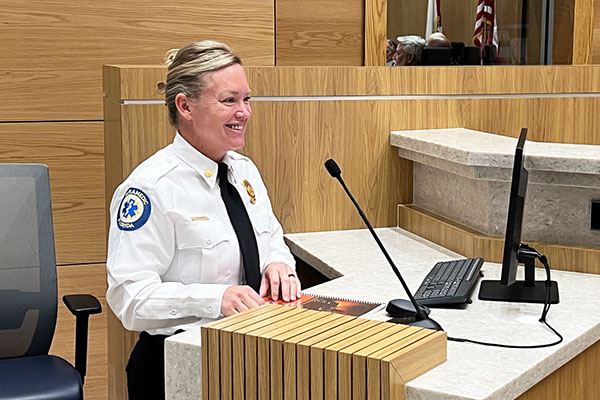Residents received two pieces of good news at the Thursday, April 17 meeting of the Royal Palm Beach Village Council. Palm Beach County Fire-Rescue District Chief Amanda Vomero provided an annual report showing that emergency response times are down in the community, and Village Engineer Chris Marsh shared news that, thanks to floodplain management activities implemented by village staff, federal flood insurance for residents will be lowered by 25 percent.
Royal Palm Beach contracts with PBCFR to provide a range of fire-rescue services. Vomero briefed the council and was pleased to report that emergency response times dropped a few seconds, to an average of six minutes, 16 seconds. The total number of calls slightly dropped from 5,050 in fiscal year 2023 to 4,934 requests for help in fiscal year 2024.
The annual report covered fiscal year 2024, from October 2023 through September 2024. Among the almost 5,000 calls for emergency assistance, 3,770 were medical-related requests for assistance, 428 were vehicle accidents and 80 were for fires. This averages to about 14 emergency calls a day, every day, within the Village Royal Palm Beach.
Residents are always covered by PBCFR services. The village boasts Station 28 and Station 29. Aside from the additional resources that the countywide agency is able to bring in from surrounding areas, permanently stationed within the village are about 15 fire-rescue professionals with eight rescue vehicles and fire trucks, including an engine with a 100-foot ladder.
Vomero is a western communities resident and a mother of three, including a teen driver.
“I started my career at Palm Beach County Fire-Rescue 24 years ago because I have always been passionate about helping others,” she said. “The high energy level required to work in fire service is just an excellent fit for me.”
Mayor Jeff Hmara was thankful for the services that the agency provides for village residents.
“You and your team provide some of the very best public safety insurance we could ever have,” he said. “The response times are so critical, especially as related to heart attack and stroke victims.”
Vomero explained that PBCFR is an “all-hazards” department that boasts rescue watercraft, Trauma Hawk air rescue, hazardous materials response teams, dark water dive rescue, large animal rescue, explosive ordinance disposal and more.
She briefed the council on a number of PBCFR programs. For example, PBCFR is one of the few agencies nationwide capable of delivering a “whole blood transfusion” program. Research shows two critical actions can improve the survival odds of a bleeding trauma patient: 1. Stop the bleeding. 2. Replace the lost whole blood. PBCFR has taken a national leadership role on this issue.
In other business, Marsh briefed the council on a letter from the U.S. Department of Homeland Security, which relayed the news that, for policies started or renewed after April 1, residents will automatically receive a 25 percent national flood insurance discount, thanks to efforts by staff to make the village more flood resistant.
William H. Lesser of the Federal Insurance and Mitigation Administration, wrote, “Congratulations! The Department of Homeland Security, Federal Emergency Management Agency (FEMA), has determined that the Village of Royal Palm Beach will increase to a Class 5 in the National Flood Insurance Program Community Rating System. The floodplain management activities implemented by your community qualify it for a 25 percent discount on flood insurance premiums for most NFIP policies issued or renewed on or after April 1, 2025. This savings is a tangible result of the flood mitigation activities your community implements to protect lives and reduce property damage.”
Jeffrey Sullivan, GIS manager for the village, explained that this was something Royal Palm Beach has been working on for years.
“The Village of Royal Palm Beach joined the FEMA CRS (Community Rating System) in 2017 in preparation for the release of the updated FEMA flood maps in October 2017,” he said. “Prior to 2017, Royal Palm Beach did not have any properties in the flood zone. This did not necessarily mean there was no flood risk for the area prior to 2017. The previous mapping in the area from 1974 and 1982 showed the village as being in Zone C (not in the flood zone). This was a time when the village and surrounding area was much less developed.”
The CRS program is a voluntary program that provides reduced flood insurance rates for municipalities that use best practices and go beyond the minimum requirements to reduce flooding risk through comprehensive floodplain management and public outreach.
CRS points are achieved by participating in activities in four categories: public information, mapping and regulations, flood damage reduction and flood preparedness.
Examples of some of the village’s public outreach activities are messages on digital signs, messages in water bills, letters and brochures to HOAs, mailings to residents in the flood zone and flood information in new resident packets.
The goal is to make all residents aware of their flood risk and make informed decisions on purchasing flood insurance.
Royal Palm Beach residents and property owners can contact the village to see if their property is in the flood zone, access flood maps, get flood insurance advice or request elevation certificates.
Visit www.royalpalmbeachfl.gov/flood for additional information.








